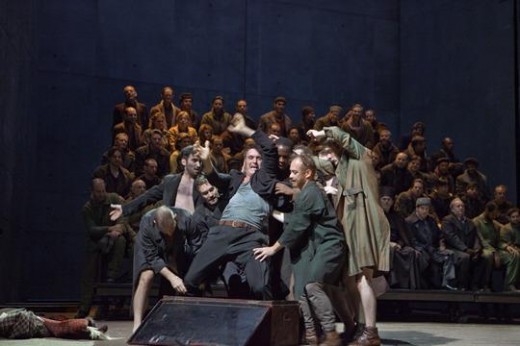The Met’s new production of Janacek’s From the House of the Dead sets high standards for the company, but as an indicator of the Gelb Era, it may be too good to be true.
Excellent all around, Patrice Chéreau’s From the House of the Dead is a new high-water mark for the Met. From the first chords to blackout, the director’s humanist, precise staging excels at capturing that ineffable sense of theatre and event. Janacek’s bleak opera is also in his sweet spot, coinciding with the director’s own favorite themes – the elusiveness of love and the mysteries of intimacy.
Just a few years ago, Chéreau staged Cosi fan tutte for the Paris Opera, and seemed at loose ends. The scenic design for that production – a rehearsal hall made of grey concrete with the repressive Vietato Fumare! stenciled onto the rear of the stage – was similar visually to this new production. (The use of text is an auteur touch for Chéreau; his 2006 film Gabrielle also uses onscreen text as a plot commentary. In From the House of the Dead, the supertitles are projected onto various parts of the set.) But in Cosi Chéreau seemed to be superimposing existential drama onto an essentially comic plot, and the results were muddy.
Chéreau’s approach to From the House of the Dead is more refined in tone and emotionally right, and he shows himself to be a gentle, artful conciliator of some dramatically tricky material. The ensemble scenes touchingly document the varieties of intimacy these men experience in the harsh reality of their imprisonment. A wounded eagle that has taken refuge in the prison is, in Chéreau’s hands, a toy – an object onto which these men project their own hopes of healing. In the pantomimes for the two orchestral prison plays, he uses bawdy sexual humor, both for levity and to suggest a more desperate kind of commerce inside the jail. Disposing of intermissions (an archaic convention?) he links the three acts with two surprise theatrical devices, both of them strikingly effective – the first, a kind of disaster, possibly symbolic of futility; the second, a huge black curtain like a ship’s sail, foreshadowing death.
From the House of the Dead is overwhelmingly a director’s opera because of its large ensemble, and because it favors a speech-like setting of the text above any display of purely musical values. It was safe in the hands of the extremely collaborative yet decisive Chéreau, who drew on his long experience in French experimental theater and film to integrate its patchwork scenes into a cohesive narrative.
The enormous cast features Peter Mattei, Eric Stoklossa, Willard White, and Kurt Streit, and at least a dozen smaller parts, in addition to a large men’s chorus and non-singing actors. Both the excellent lighting design, by newcomer Bertrand Couderc, and the concrete gulag set by Richard Peduzzi, explored subtle shades of grey. The appropriately drab and institutional costumes, by Caroline de Vivaise, suggested uniforms of the prisoner or Nazi variety without being too specific
Mattei connected brilliantly to the role of Shishkov, the tormented man who killed for love. Is it unfair to say that he sang almost too mellifluously, where some growl may have been more believable? Esa-Pekka Salonen, in his Met debut, got mostly precise playing from the Met Orchestra, though they sounded under-rehearsed in places, with spotty intonation in the difficult close-harmony violin writing. His reading of score, characteristically cool and detached, produced a robust and agile accompaniment throughout.
From the House of the Dead, co-commissioned with the Festival Aix-en-Provence, was produced in Europe and filmed for DVD there before coming to New York. [Following up on operabitch’s comment below, and in the interest of accuracy: it’s a “production of the Metropolitan Opera and the Wiener Festwochen, in co-production with Holland Festival, Amsterdam; the Festival d’Aix-en-Provence; and Teatro alla Scala, Milan.” – LC] The re-staging here must have commanded an enormous amount of resources and rehearsal time. Percussive and episodic, it lacks the sweep and lyricism that make Jenufa and Kát’a Kabanová repertory staples since the 1990s Janacek craze, and it is not likely to match their popularity. Monday night’s audience, younger and hipper than usual, received the performance with cautious enthusiasm, but the atmosphere was somewhat that of a succès d’estime.
It would be gratifying to see Chéreau get his hands on a Met production of a standard repertoire work with a greater musical appeal. Though this production represents the best of Peter Gelb’s intentions for the New Met, a fringe piece like From the House of the Dead cannot define the company. This leads one to wonder how sustainable such endeavor might be for a company that produces so much opera as they do, and whether it is fair to expect this quality of work from other new productions this season.
We’ll find out soon. Les Contes d’Hoffmann, in a new production by Barlett Sher, will open December 3. Carmen, opening December 31, is the next popular repertory piece to be replaced since Luc Bondy’s Tosca opened the season. The incumbent Carmen, a familiar and effective Franco Zeffirelli warhorse, will be missed by many, and director Richard Eyre has his work cut out for him.







Comments